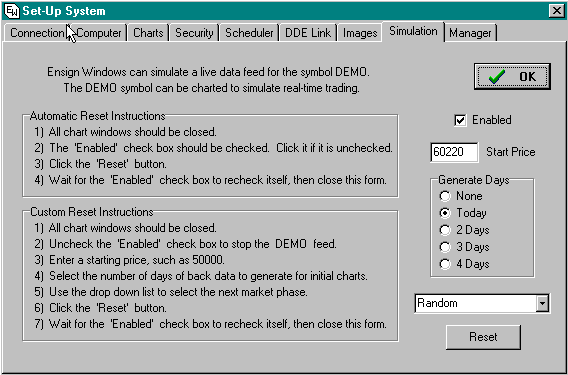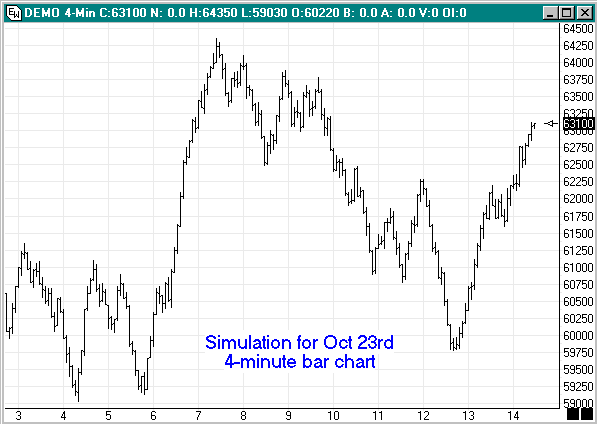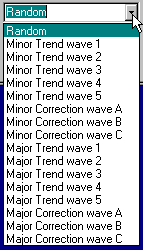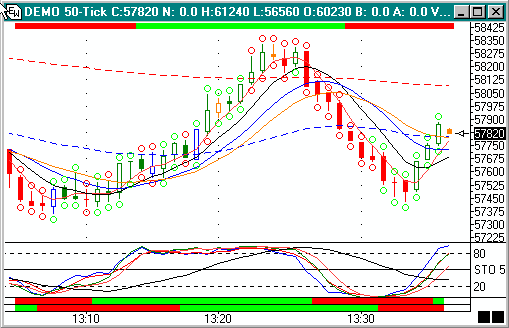by Howard Arrington Ensign Windows has a feature which simulates a real-time data feed for a dummy symbol named DEMO. This data is generated 24 hours a day, 7 days a week, and gives traders the opportunity to simulate real-time trading when markets are closed. Many traders meet in the B-Line chat room in Ensign Windows during evening hours and on weekends to watch DEMO charts and discuss trading systems, study parameters, chart formations, alerts, and trading signals. You are invited to stop in the chat room and join in the educational fun of pitting your trading abilities or trading system against the simulated real-time feed. One important principle is to be synchronized with other traders so everyone who watches DEMO sees the same chart pattern and continues to update their charts with the same tick sequence. Synchronization is accomplished in Ensign Windows by first clicking menu SetUp | Simulation to see this form.
The instructions are printed on the form. Basically, click the Reset button while the Enabled box is checked and the data set generated for the DEMO symbol will be identical to others who are following DEMO charts. The DEMO charts will update with a 'live' tick every second. There is genius in the design of this simulated data feed. It combines elements of randomness through the use of a random number generator, yet incorporates some orderliness so principles of Elliott wave theory, Fibonacci, Pyrapoint, support and resistance, and cycle relationships will be found in the chart patterns.
This 4-minute bar chart for DEMO looks like a real chart. All of the standard patterns of trends, congestions, head and shoulders, rounding tops and bottoms, double tops and bottoms, triangles, and break outs can be found in DEMO charts. The simulated feed for DEMO can be used for the following purposes:
While most users will follow the Automatic Reset Instructions, the Demo feed does have the ability to be customized. Custom settings would permit the same sequence to be run again, or for the next market phase to be selected in advance. Some may want to use this feature to test their trading skills or trading system in certain types of markets. This list shows the market phases that can be pre-selected to be the next pattern experienced in real-time.
This is what Rick Fath has to say about DEMO:
This is what Judy MacKeigan has to say about the simulated DEMO feed.
Trader Profile: ES: You go by Buffy in the B-Line chat room. How did you come to choose a nickname of Buffy? JM: It is one of my kitty cats names - the other is Biffy. I forgot all about the vampire slayer when I chose it. Many still remember me as Unicorn. ES: I understand you are a day trader, but tell us more about your trading style. JM: I love day trading because it can really be whatever I want it to be - many trades or a few trades depending on how focused I am. I learned a long time ago don't trade when you are not "in the mood". So I trade when I feel like it, and when I am not trading, I totally enjoy being in the B-Line chat room typing comments, posting charts and answering questions. My style is very short term. I use constant tick charts of 30, 50, 75, 150 and 300. I run pretty tight stops as I do not like to give much back or ride out the retracements. I would rather reenter the trade when the trend continues. So, I will have 3 trades in a trend where a trend trader might only have one. My goal each day is to end up plus for the day including broker fees. The rest seems to take care of itself. ES: How often do you meet your daily goal? ES: What do you trade? JM: I trade the NQ futures. Before trading this, I was a stock day trader and that was usually in heavy volume Nasdaq stocks. So I felt more familiar with the NQ than the ES. I really enjoy the switch to the e-mini as I am not looking at stock charts all night. Feel I can take time off anytime and not have to watch the market for a few days to figure out where it is. And I can do what I really love which is hang out in the E-mini Traders Anonymous chat room and have great discussions on trading and help other traders learn to fish. ES: What kind of setup does one need to be a day trader like you? JM: I have two computers. One is a 450 MHz Pentium II with 3 monitors running Ensign Windows and trading platform. The other computer is a 500 MHz Pentium III with two monitors that is used for the chat room, E-mail, and web chores. Seems to work out well for me. ES: Which data feed do you use, and how do you like it? JM: I use eSignal with the Ensign Windows software for charting. I find this combination very reliable. Ensign Windows charting is very powerful and with the latest revisions much easier to use. The indicators on indicators and the simulated real time symbol DEMO are two of my favorite features. I never knew the value of constant tick charts were until I started using Ensign Windows. The minute charts can hide so much - tests of swing highs/lows, flags, etc - I seriously doubt I will ever go back to trading minute charts. I do watch them though to answer questions another trader in the room might have who doesn't have tick charts available to them. ES: Part of your trading system is covered in the next article in this newsletter, but would you share more of your rules with us? JM: I do not chase a trade - if I miss it I miss it - there will be another train leaving the station. Also if I miss it it usually means I am not focused enough, so just as well. I decrease position size if I have two losing trades in a row. Although it hasn't happened in quite a while, I used to watch myself for revenge trading: The "I'll get this back" trading. When I was learning, and still had a trading simulator, I used to allow myself only 3 losing trades before I had to go back to the simulator. As I mentioned already, I only trade when I feel like it and when the odds are in my favor. When I suspect chop, I sit on my hands or take a break. The moving averages being flat, especially the 50 and 200 EMA, and the price trapped between the 50 and 200 EMA on the 75 tick chart are two clues I use to indicate a chop zone. It is time to just watch until the market has direction again. In the B-Line chat room, we always know what reports are coming out and I am never in the market when they do. ES: How important is good health to trading success? JM: I think that is very important Howard. Just like it is to do your best at a regular job you need to be mentally alert to beat the market chess game. If I am not having a "sharp" day then I tend to do a longer time frame and have fewer trades. ES: What protection do you have in place to keep from having big loss days? JM: I hate losing money so hardly ever have more than 3-4
pts at risk myself. A big loss day hasn't happened is quite
a while. I always use stops even if scalping and plan on
exiting at market. Then the stop will be further away and
canceled when I am flat. Back when I started I would get
all upset if I had a day cost me $300. It is just me and my
way. JM: I use PFGbest. I tried others, but the PFGbest
platform seems to be the least likely to cause errors for
me. When I was a beginner that was important. They were
also more than willing to answer beginner questions when I
called. I thank Teresa Lo and Mike Bruns from
www.trendvue.com for teaching me how to do this. No one can
teach diabolical thinking better than Teresa Lo. Received
many words of encouragement from others also. JM: I dabbled in stocks from 1994 on, and was lucky with a few like LU, PIXR and CWTR. Due to Ed, my guy, being very ill I did not trade much in 1998. He passed away in June of that year. I decided I did not want to go to work for others and did love the challenge of the market. Pit Bull book confirmed this - read it in one sitting. So that fall bought lots of books and started day trading stocks the end of 1998 until last fall. At that time, Silicon Investor had a great thread called
"TA for the Beginners". I learned a lot about TA from the
great posters there so willing to share their knowledge -
Richard Estes, Bob, Sean, Claud, Andy and many others. Just
about a year ago I bumped into Teresa Lo on Silicon Investor
and she listened to my complaints about the market and no
life looking at all those charts and she suggested I try
futures. With the holidays coming, I started under her in
January this year. Took many of her Master Trader Classes
along with Mike Bruns classes. Started with PFGBest
simulator in May and real account in June. I have not had a
losing month, but was very quick to go back to the simulator
if the day was not going well JM: I have experience with Qcharts, TC2000 for end of day, IQCharts, and QPlus for scanning. Last April even playing techie did not work to keep Qcharts up and running. That is when I found eSignal, but their charting software at the time was not even close to what I was used to with Qcharts. I went searching and found Ensign Windows. The combination of Ensign Windows and the eSignal Internet feed has proved to be great for day trading the e-minis. Ensign's capability of running the simulated RT symbol DEMO has just been an added bonus. Being able to practice my signals with my system when market is down cut down on the confidence curve. This template (see the next article) is a system I used to use with stocks but have modified a bit for the e-minis. It is much easier with all the indicators in one window than before when using other software. The market is like a 3 dimensional chess game. You need to watch a time frame higher and one time frame lower than the one you are trading. Ensign's response to questions, their great classes every Wednesday, and Howard's willingness to work with traders to make it truly a trader's charting program sure makes it the best IMHO (in my humble opinion). ES: Do you have anything else you would like to pass on? JM: I would have to say my list of importance is: Guess that is my attitude toward Duplicate Bridge - try to win this hand - the score takes care of itself. Research Tip: by Judy MacKeigan My basic style is not to give very much of anything back to the market. I would rather exit the trade and reenter than have a retracement turn into much more. For example, those of you familiar with Retro will see that one of Retro's trades might be 3 to 5 trades for me. My files have posted to the Internet so you can download them. In Ensign Windows, click the Internet Services button on the main button bar. Click on the Upgrade tab on the Internet Services form. Select the Sample Workspace bullet, and click the Connect button, and then click the Download button when it becomes enabled. This downloads my workspace file. Do the same thing by selecting the Sample Template bullet and click the Download button. Now you have my workspace shown as Ensign on the Workspace panel, and my template shown as Ensign on the Template panel. You may wish to Resave both to use another name besides Ensign because the Downloader always uses the name Ensign when it saves the samples to your computer. Now when you click on the template button in Ensign Windows and apply Ensign you will have my system on your chart. Here's a quick overview of the indicators included in the Ensign template::
When the "B line" is decked above 80 in the main TF and the next shorter TF, the up-trend is strong and might carry over to the higher TF (vice versa for "B line" below 20 in down trend). I have now seen this happen right up through the 15 minute time frame on a strong downtrend. These indicators work in all time frames. You need to watch at least one TF higher and at least one lower. For example, I trade the 75 constant tick chart but have the 30, 50, 150, and 300 constant tick charts up also. The system also works on minute charts. The signals aren't as fast, which is true of all indicators, but it still gives you the signals. The divergences in the highs/lows of the stochastic can often call a failed retest of high/low before price does. When the B line is rising and the Stochastic falls to meet it and then turns up, it usually signals the start of another leg up. (See example www.dacharts.com, 2001-10-15 folder, buffy-temp3 sig4.gif) When the B line is falling, and the Stochastic rises to meet it and then turns down again, it usually signals the start of another leg down. There were an equal number of people who did and didn't want a color band below the top one for the B line. To add this to your template right click on chart, click on draw tools, click on the alarm clock. The cursor will turn into a pencil when over the chart. Click on the B line. A properties window will come up. Make it exactly like the one posted (See example www.dacharts.com, 2001-10-15 folder, Buffy-B line color band5.gif), click on OK. It should now be on the chart. Green is used for up and yellow for down to quickly know which band is which. If you want to add to templat3 or make another template with it included with other indicators on templat3, right click on chart. Click on template, click on SAVE, click on the template you wish to save it to. Summary: System for day trading the Nasdaq and S&P index futures. Signals can be as simple or as complicated as you wish to make it. Strengths: Uses multi-timeframe analysis. Frequent trading opportunities. Leaves very little on the table. Very suitable for part time trading. Can scalp (tick charts) or trend (minute charts) trade intra-day. (May also be used for stocks with 60 minute - daily - monthly charts.) Weaknesses: If scalping, requires close attention to the charts. Intensity: Scalping may have 20+ trades per day. Trend trading depends on time frame used. Resources: Real-time charts posted throughout the day to the www.dacharts.com web site, real-time voice chat peer support in the B-Line chat room using Ventri1o port 3800, after-hours simulated trading with Buffy, voice chat Q&A. Study Tip: by Ira Tunik I guess it depends on which book you read. One says Stochastic is to be used in trending markets only, another says to use divergence only for calling tops and bottoms and a third will say it is totally useless. All 3 are right and wrong at the same time. Any indicator is useless unless you understand what it was designed to do and how it was designed to be used. Stochastic was designed based upon cycles. The static use of 14,3,3 for the Stochastic parameters will get you in trouble unless you are trading a 28 bar cycle. Stochastic was designed to use the 1/2 cycle. Divergence is a warning of an impending change. You can get 2, 3, 4 or more divergent tops or bottoms. There is no specific number given for the indicator. You can back test the heck out of Stochastic and come up with the wrong answer because it is the current cycle width that determines the accuracy of the indicator. Do you want to use regular or exponential moving averages? That is what the 3,3 is: the moving average and the moving average of the moving average. The Moore report used to give the stochastic indicators for the various commodities and they changed every month, and they were different for up moves and down moves for the same commodity. That is what they got by back testing. If you check the cycles, you will find that they are fairly constant for a specific commodity, stock or index. Usually all the stocks in a sector will trade on the same cycle. There are always the exceptions. Cycles are always measured from low to low. Never from high to high. A low is defined as a bar that is lower then the previous bar and lower then the following bar. Therefore, you can have a low in the middle of an up trending or down trending move. For a better understanding of cycles read Hurst's book. It is about the best out, even though it is about 30 years old, and still pertinent. Like any other indicator that I have found, it will not stand alone as a entry and exit tool for a trading system. It can be used very advantageously in a trading system. I use it in mine and find it very helpful |



